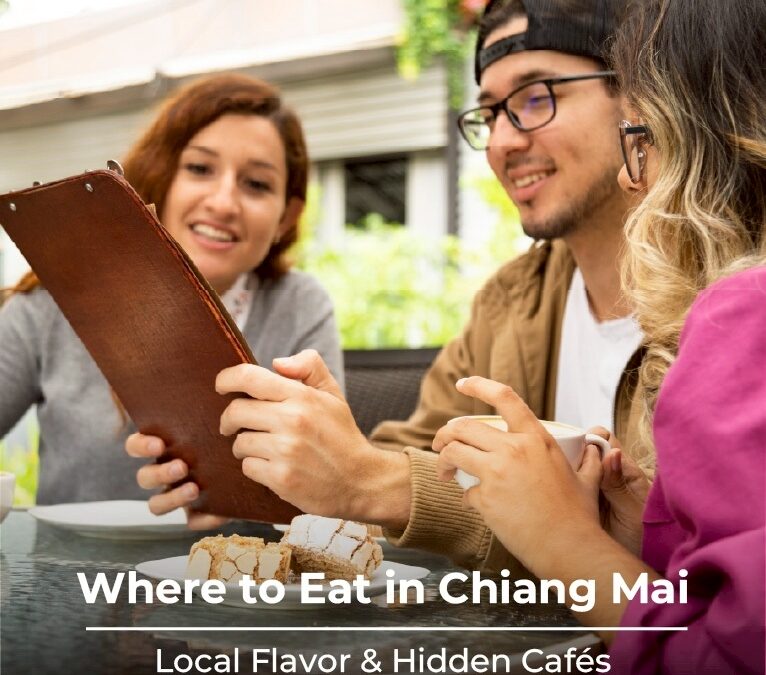Chiang Mai is not just a city known for its ancient temples and mountain scenery—it’s also a paradise for food lovers. The city blends the charm of traditional Lanna cuisine with modern flavors, creating a food culture unlike anywhere else in Thailand. Aromas of herbs, spices, and sizzling grills fill the streets, drawing both locals and visitors.
Table of Contents
If you’re planning a trip and asking yourself, “Where to eat in Chiang Mai?” the answer goes beyond the famous restaurants on review sites. True flavors are often found in small, family-run shops and night markets that locals frequent. This guide will take you through Chiang Mai’s diverse food scene—from must-try Northern dishes to hidden cafés and insider dining tips.
Chiang Mai Food Scene: A Unique Lanna Dining Culture
Eating in Chiang Mai is more than satisfying hunger—it’s a way of life passed down for generations. Locals often say, “Rice is life, chili paste is the heart,” since every meal usually includes rice paired with nam prik (chili paste) and fresh vegetables.
The city’s cuisine also reflects influences from Myanmar and Yunnan, resulting in staples like Gaeng Hung Lay (Northern pork curry) and Yunnan-style noodles. This cultural mix has turned Chiang Mai into a destination where people don’t just visit temples or mountains—they come to eat.
A homemade Hung Lay curry at a local market, rich with herbs and spices, proves that the best flavors often come not from fancy restaurants, but from humble community kitchens.
Must-Try Local Eats: Signature Northern Thai Dishes
Northern Thai cuisine is distinct—crafted with local herbs, unique spices, and recipes rooted in family tradition. These dishes are more than food; they reflect the warmth and heritage of the Lanna people. To visit Chiang Mai without trying them would be to miss the city’s essence.
- Khao Soi – Egg noodles in a coconut curry broth topped with crispy noodles. Try Khao Soi Mae Manee (local favorite) or Khao Soi Lamduan Fah (long-standing classic).
- Sai Ua (Northern Herbal Sausage) – Infused with lemongrass, galangal, and kaffir lime leaves, best enjoyed with sticky rice. Sai Ua Khun Saeng at Somphet Market is a top pick.
- Larb Kua (Northern Larb) – Different from Isaan larb, made with local spices like makhwaen (Sichuan pepper). Recommended spot: Larb Kai Ban Hong.
- Nam Prik Noom with Pork Crackling – A Northern staple, especially during New Year festivals.
- Gaeng Hung Lay – Slow-cooked pork belly curry, fragrant with garlic and ginger, meltingly tender.
Skip the touristy zones and try neighborhood eateries. The flavors are more authentic, unadjusted for outside palates.
Local Favorites: Where Chiang Mai Locals Really Eat
Food tastes best when you experience it the way locals do. Community-run restaurants pass down authentic recipes without diluting the flavors for tourists. Here are a few must-visit local spots:
- Jok Sri Phing – A legendary porridge shop open from 5 AM, famous for silky pork congee topped with crispy noodles.
- Anchan Noodles – Known for its purple noodles colored naturally with butterfly pea flowers. Not just Instagram-worthy—also deeply flavorful.
- Khao Soi Samerjai – Serving Chiang Mai for over 40 years, preserving the perfect balance of curry spice and coconut cream, topped with crispy noodles and pickled shallots.
Why eat local? Affordable prices, bold flavors, and the chance to connect with Chiang Mai’s daily life through every dish.
Hidden Cafés: Chiang Mai’s Secret Coffee Culture
Chiang Mai is also Thailand’s café capital, with over a thousand coffee shops—each with its own character. These cafés are more than places to sip coffee; they’re spaces for creativity, relaxation, and storytelling.
- Akha Ama Coffee – A pioneer that helped put Akha hill tribe coffee on the global map. Community-driven and socially impactful.
- Graph Café – A tiny shop with a big reputation for experimental coffee creations, blending art and science in every cup.
- No.39 Café – A garden hideout with lakeside seating, perfect for lazy afternoons with coffee and cakes.
- Gateway Coffee Roaster – Tucked away in the Wat Ket area, inside a charming wooden house filled with nostalgia and slow-drip mastery.
These hidden gems reveal another side of Chiang Mai—authentic, inspiring, and rich with local stories.
Night Markets & Street Food: The City After Dark
To truly feel Chiang Mai’s heartbeat, you must visit its night markets. After sunset, the quiet city transforms into a vibrant hub of street food, handicrafts, and local music.
Markets worth exploring:
- Tha Phae Sunday Walking Street – A weekly highlight featuring hard-to-find local dishes, handmade crafts, and live cultural performances.
- Kad Luang (Warorot Market) – Chiang Mai’s oldest and largest market, where locals shop daily for fresh produce, dried goods, and traditional snacks.
- Chiang Mai Night Bazaar – The city’s liveliest night market with global food stalls, souvenirs, clothing, and buzzing nightlife.
Walking down Tha Phae Walking Street on a Sunday night—with music in the air, the aroma of grilled sausages, and the glow of Lanna lanterns—is an unforgettable memory that defines the essence of Chiang Mai.
Tips & Tricks: Eating Like a Chiang Mai Local
Dining in Chiang Mai is also about living the local rhythm. Here are some tips to make your food journey more authentic:
- Breakfast – Start with strong local coffee or comforting Jok Sri Phing congee before sunrise.
- Lunch – Go for rich Northern dishes like Khao Soi at old neighborhood shops for true flavor.
- Dinner – Head to night markets by 6 PM to beat the crowds and sample endless street food: from sai ua to nam prik noom and traditional desserts.
Conclusion
Chiang Mai is not just a tourist city—it’s a city of flavors and traditions, where every meal tells a story. From authentic Northern Thai dishes cooked with heritage herbs, to hidden cafés with creative brews, to night markets alive with food and music—every bite is an experience, every meal a journey.
If you ask, “Where to eat in Chiang Mai?” the answer is more than a list of restaurants. It’s an invitation to explore the city’s way of life—through flavors, aromas, and memories that linger long after your trip ends.






